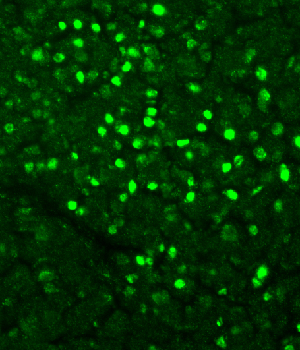Research into the role of proteins called sirtuins in enhancing longevity has yielded contradictory results from many different scientists - while it's been fine for mouse studies, weaning human babies on a diet near starvation isn't possible. As a result, the benefits of a low-calorie diet are accepted by people who want to believe it.
A new paper seeks to peer into the fog with some clarity. The authors say they have identified the mechanism by which a specific sirtuin protein called Sirt1 operates in the brain to bring about a significant delay in aging and an increase in longevity associated with a low-calorie diet. They show how Sirt1 prompts neural activity in specific areas of the hypothalamus of the brain, which triggers dramatic physical changes in skeletal muscle and increases in vigor and longevity.
Imai’s team studied mice that had been genetically modified to overproduce Sirt1 protein. Some of the mice had been engineered to overproduce Sirt1 in body tissues, while others were engineered to produce more of the Sirt1 protein only in the brain.
New research has identified the mechanism by which the sirtuin protein Sirt1, shown in green, operates in the brain to delay aging and increase longevity. Credit: Imai lab at WUSTL
"In our studies of mice that express Sirt1 in the brain, we found that the skeletal muscular structures of old mice resemble young muscle tissue,” said Shin-ichiro Imai, MD, PhD, of Washington University School of Medicine in St. Louis. “Twenty-month-old mice (the equivalent of 70-year-old humans) look as active as five-month-olds. We found that only the mice that overexpressed Sirt1 in the brain (called BRASTO) had significant lifespan extension and delay in aging, just like normal mice reared under dietary restriction regimens."
The BRASTO mice demonstrated significant life span extension without undergoing dietary restriction. “They were free to eat regular chow whenever they wished,” he said.
In addition to positive skeletal muscle changes in the BRASTO mice, the investigators also observed significant increases in nighttime physical activity, body temperature and oxygen consumption compared with age-matched controls.Mice are characteristically most active at night. The BRASTO mice also experienced better or deeper sleep, and both males and females had significant increases in longevity.
The median life span of BRASTO mice in the study was extended by 16 percent for females and 9 percent for males. Translated to humans, this could mean an extra 13 or 14 years for women, making their average life span almost 100 years, Shin said. For men, this would add another seven years, increasing their average life span to the mid-80s.
Delay in cancer-dependent death also was observed in the BRASTO mice relative to control mice, the researchers noted.
Imai said that the longevity and health profile associated with the BRASTO mice appears to be the result of a shift in the onset of aging rather than the pace of aging. “What we have observed in BRASTO mice is a delay in the time when age-related decline begins, so while the rate of aging does not change, aging and the risk of cancer has been postponed.”
Having narrowed control of aging to the brain, Imai’s team then traced the control center of aging regulation to two areas of the hypothalamus called the dorsomedial and lateral hypothalamic nuclei. They then were able to identify specific genes within those areas that partner with Sirt1 to kick off the neural signals that elicit the physical and behavioral responses observed.
“We found that overexpression of Sirt1 in the brain leads to an increase in the cellular response of a receptor called orexin type 2 receptor in the two areas of the hypothalamus,” said first author Akiko Satoh, PhD, a postdoctoral staff scientist in Imai’s lab.
“We have demonstrated that the increased response by the receptor initiates signaling from the hypothalamus to skeletal muscles,” said Satoh. She noted that the mechanism by which the signal is specifically directed to skeletal muscle remains to be discovered.
According to Imai, the tight association discovered between Sirt1-prompted brain activation and the regulation of aging and longevity raises the tantalizing possibility of a “control center of aging and longevity” in the brain, which could be manipulated to maintain youthful physiology and extend life span in other mammals as well.
Citation: Satoh A, Brace CS, Rensing N, Clifton P, Wozniak DF, Herzog ED, Yamada KA and Imai S. Sirt1 extends life span and delays aging in mice through the regulation of Nk2 homeobox 1 in the DMH and LH. Cell Metabolism 18:1-15, Sept. 3, 2013.




Comments